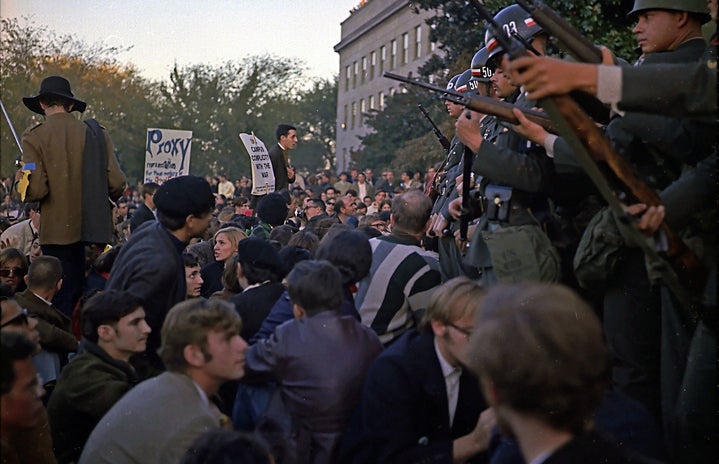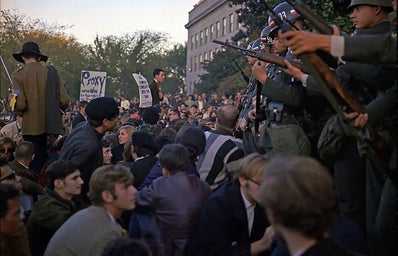The year was 1967. The counterculture movement was a quickly developing force, and anti-war efforts were in full swing as the Vietnam War raged on. In a small painting studio in San Francisco, a gathering of self-proclaimed hippies and anti-war activists sat in discussion. Among them was Jerry Rubin, co-founder of the Yippies (Youth International Party), along with Abbie Hoffman.
The group was brainstorming possible protest displays — the original idea was to occupy the Capitol Building, but members feared it would send the unintended message that they were attempting to halt democracy. The next suggestion brought them to the decision of occupying the Pentagon— what they saw as a symbol of the war and violence they were so passionately fighting against. Poet Gary Snyder joked that the Pentagon didn’t need a protest but an exorcism to truly cleanse it. Taking the antic one step further, artist Michael Bowen proposed they should conduct a ritual to lift the Pentagon off American soil and into the air. In the news after the fact, TIME Magazine reported the group’s intention as wanting to turn the building orange and make it vibrate until all evil emissions had fled.
To be clear, the majority of people within the group were very involved in the regular usage of acid and hallucinogens — through this lens, the birth of such an outrageous idea starts to make more sense. Still, members like Rubin and Hoffman didn’t believe the building would actually float, but they were clever protestors with a taste for theatrics, so the symbolism was not lost on them. They saw the idea as a significant act that could spread their message in a big way.
Another organizer of the march, Keith Lampe, is quoted as saying, “What a charming moment. All of us ‘radicals’ there suddenly became ‘moderates’ because Michael really expected to levitate it whereas the rest of us were into it merely as a witty media project.” Indeed, Bowen and several other members believed the ritual would actually work, and Bowen arrived at planning meetings with concrete ideas on how to make their goal come to fruition.
On the day of the event, tens of thousands of people showed up to march on the Pentagon. Leaflets containing a program detailing the ritual were passed out to attendees. An excerpt from the leaflets reads,
“We Freemen, of all colors of the spectrum, in the name of God, Ra, Jehovah, Anubis, Osiris, Tlaloc, Quetzalcoatl, Thoth, Ptah, Allah, Krishna, Chango, Chimeke, Chukwu, Olisa-Bulu-Uwa, Imales, Orisasu, Odudua, Kali, Shiva-Shakra, Great Spirit, Dionysus, Yahweh, Thor, Bacchus, Isis, Jesus Christ, Maitreya, Buddha, Rama do exorcise and cast out the EVIL which has walled and captured the pentacle of power and perverted its use to the need of the total machine and its child the hydrogen bomb and has suffered the people of the planet earth, the American people and creatures of the mountains, woods, streams, and oceans grievous mental and physical torture and the constant torment of the imminent threat of utter destruction…”

Ed Sanders — a poet, activist, and long-time member of the band Fugs — was present and loudly chanting, “out, demons, out.” Hoffman set to work pairing up couples and encouraging them to engage in public displays of affection to surround the Pentagon in “communal love.” 200 pounds of flowers were brought to the event, which led to the iconic images of gun barrels juxtaposed with daisies as the 82nd Airborne Division formed a barricade between protestors and the building.
Despite the positive turn-out at the event, the movement did face considerable backlash after the fact. To many Americans, the march was entirely ridiculous and the message wasn’t even worth listening to. TIME Magazine actually defended the Pentagon and criticized the movement for Bowen’s often expressed idea that five-sided shapes are inherently dark or occult. TIME stated, “Actually and expectedly, the hippies are wrong. Most religions, including Judaism, Christian mysticism and occult Oriental sects, find the Pentagon to be a structure connoting good luck, high station, and godliness.”
Did the “Levitate the Pentagon” march really alter the course of history? Many argue that it changed public perception. Even though the proposed goal was (obviously and unsurprisingly) unsuccessful, some propose that the Pentagon was levitated and therefore changed metaphorically in the minds of the public. Undoubtedly, the movement was a significant pioneer in guerilla media — using shocking or unconventional means to make a point or advertise a product. Whether you agree with the protestors’ core message or not, or if you believe they had an impact or not, “Levitate the Pentagon” remains to this day one of the most interesting and unique iterations of political theater throughout history.



